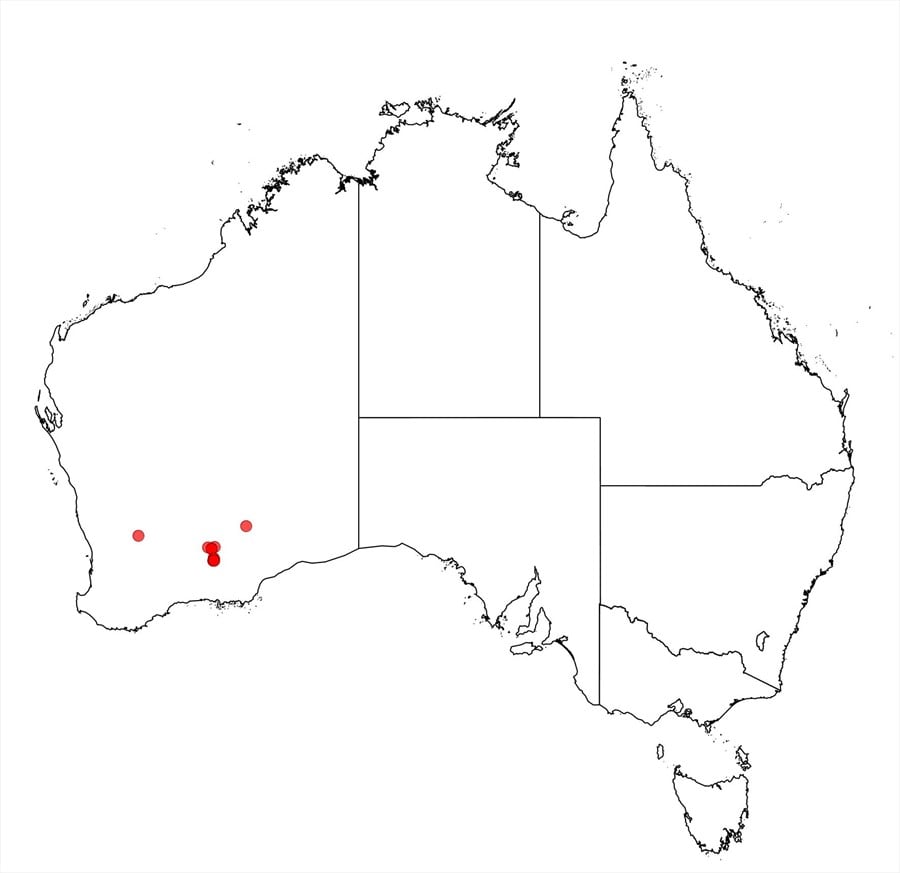Acacia fraternalis Maslin
WATTLE
Acacias of Australia
Family
Fabaceae
Distribution
Occurs near Norseman and Higginsville (now-abandoned township about halfway between Widgiemooltha and Norseman) with outlier at Cundeelee Mission (c. 120 km due NE of Higginsville), W.A.
Description
Obconic shrub 1–3 (–5) m tall. New shoots resinous. Branchlets glabrous except often sparsely and minutely appressed-hairy at apices. Phyllodes terete to flat, mostly ascending to erect, not rigid, narrowly linear, normally shallowly incurved, 60–100 (–120) mm long, 0.5–1.5 (–2) mm wide, short-acuminate with delicate, curved and innocuous tips, glabrous; longitudinal nerves numerous, often rather indistinct. Inflorescences 1–2 (–3)-headed racemes; raceme axes 1–10 (–20) mm long, often terminated by vegetative bud or growing out when heads are in bud; peduncles 4–9 mm long, sparsely to moderately appressed hairy, occasionally glabrous; heads globular, 3.5–5 mm diam., 20–30-flowered, light golden, often resinous in bud. Flowers 5-merous; sepals free. Pods narrowly oblong to broadly linear, 30–60 mm long, 7–10 mm wide, firmly chartaceous, mostly shallowly curved, often slightly undulate, obviously raised over seeds alternately on either side, ±glabrous, nerveless or obscurely transversely nerved. Seeds transverse to oblique in pods, obloid to ellipsoid or ovoid, 3–3.5 mm long,; aril clavate to oblong and 1/4–1/3(–1/2) as long as seed.
Phenology
Flowers: Nov.-June; mature pods often co-occur with the inflorescences.
Habitat
Commonly occurs in clay, sandy clay or sandy loam on the slopes of granite and/or basalt hills in very open low woodland and Mallee heath with Triodia ground cover or open Eucalyptus woodland (that includes E. lesouefii) and tall shrubland dominated by Acacia acuminata; the Cundalee plant occurred on red sand.
Notes
Most closely related to A. warramaba which is distinguished by having consistently flat (never terete) phyllodes that are broader and commonly shorter, and more numerous flowers per head. Also has some affinities with A. papyrocarpa that has clearly appressed-puberulous new shoots with hairs persisting on mature phyllodes, flat, openly reticulately nerved pods and larger, longitudinal seeds. See B.R.Maslin, Nuytsia 24: 158 (2014) for further discussion.
The phyllodes on specimens from the vicinity of Higginsville are consistently flat but elsewhere they are terete to sub-terete.
Author
B.R. Maslin
This identification key and fact sheets are available as a mobile application:
URL: https://apps.lucidcentral.org/wattle/
© Copyright 2018. All rights reserved.






